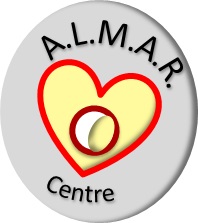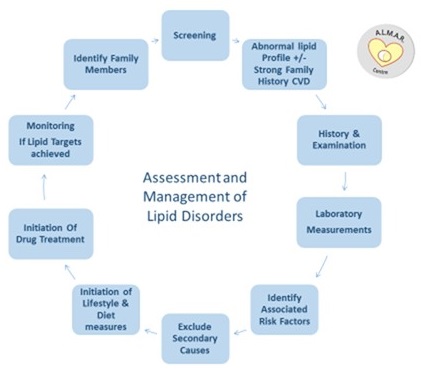 Who are we?
Who are we?
The Advanced Lipid Management & Research (ALMAR) Centre was developed at Tallaght University Hospital (TUH) since 2017 to investigate and treat patients with cholesterol and triglyceride problems. These conditions may lead to heart disease or life threatening pancreatitis. Many patients have complex problems such as responding poorly to drugs or having difficulty reaching the cholesterol levels required to prevent heart disease. A number of these patients have genetic problems (occurs in families) which need to be checked out so that other family members can be helped.
How do I get an appointment?
If your cholesterol or Triglyceride levels are abnormal your GP/Doctor will refer you to our Lipid Management Service.
The ALMAR centre holds a Lipid (cholesterol) Management clinic weekly on Friday mornings but also patients are seen at other times throughout the week to facilitate the management of their cholesterol.
What are Lipids?
Lipids is a term that refers to cholesterol or fats such as Triglyceride. The body makes its own cholesterol but also obtains cholesterol from food. We need cholesterol to make new cells, hormones, vitamin D and bile acids which help us digest and absorb fats.
Cholesterol travels through the bloodstream bound to proteins known as lipoproteins. These include Chylomicrons which carry Triglycerides from the intestine to the liver, VLDL (very low density lipoproteins), which distribute triglycerides and then eventually these become LDL. LDL (low density lipoproteins) transports cholesterol to the body cells and HDL (high density lipoproteins) which transport excess cholesterol from body cells. A high level of LDL nicknamed ‘Lousy, Lethal’ cholesterol leads to artery narrowing, whilst HDL “Healthy Hoover” cholesterol, transports cholesterol from around the body to the liver for removal.
How might high cholesterol or high triglyceride levels affect me?
Abnormal levels of cholesterol are associated with a number of problems, such as build-up of cholesterol which narrows artery walls (atherosclerosis). This can cause
- A heart attack (myocardial infarction)
- A stroke
- Narrowing of the arteries that supply the legs (peripheral arterial disease).
Abnormal levels of Triglyceride leads to the development of pancreatitis which can be life threatening.
What are the symptoms of High Cholesterol and High triglycerides?
There are usually no signs or symptoms of high blood cholesterol or Triglyceride and therefore people are unaware that they have high cholesterol unless they have some obstructive artery problems or pancreatitis.
Some Facts about Cholesterol
- High cholesterol levels increase one’s life time risk of heart disease and stroke.
- It is estimated that one in nine people have insufficient HDL cholesterol levels, which normally protect against heart disease.
- Genetic disorders of “LDL” cholesterol occur in approximately one in 200 people. This means that roughly 24,000 Irish people have these disorders and are at very high risk of developing heart disease if left untreated.
- Approximately 80% of individuals are unaware of their cholesterol problems and many are only diagnosed after a heart attack or stroke.
- In those with high LDL cholesterol or not enough HDL cholesterol other factors can increase their heart disease risk. These include diabetes, obesity, high blood pressure and smoking.
- Even for those who know they have high cholesterol, they may not respond to treatment, or are unable to tolerate cholesterol lowering drugs.
- While a healthy lifestyle helps is essential in reducing cholesterol levels over 80% of the cholesterol level is controlled by genes inherited from your family.
Some facts about Triglyceride
- Triglyceride is an important energy source for the body and also when stored under the skin acts as an insulator to maintain body temperature.
- Triglyceride is main form of fat in foods.
- High Triglyceride levels are the third most common cause of pancreatitis after gallstones and alcohol.
- Moderately high levels of triglyceride are linked with abnormal fat particles in the blood which increase the risk of heart disease.
- When Triglyceride levels are very high, it is due to the presence of very large Triglyceride particles in the blood stream. These can block up small blood vessels in your pancreas gland which leads to pancreatitis.
Risk Factors that increase the risk of artery damage from high cholesterol levels include.
High Blood pressure which can damage the artery wall allowing more cholesterol to accumulate
Smoking: Smoking lowers the “healthy” HDL cholesterol and makes LDL particles more dangerous increases artery damage.
Diabetes: Diabetes is associated with high blood sugar which creates dangerous LDL particles and stickiness inside the lining of the arteries. This leads to increased build of cholesterol which may narrow the artery wall.
Lack of exercise: Exercise helps increase HDL, or "healthy," cholesterol levels and may also reduce blood LDL levels.
Poor diet: Foods that are high in cholesterol and saturated fat, such as red meat and full-fat dairy products increase blood LDL cholesterol levels. Trans fats which are found in convenience foods and takeaway meals also raise your cholesterol levels.
Obesity: Having a body mass index (BMI) of 30 or greater puts you at risk of high cholesterol.
Factors that increase the levels and risk form high triglyceride include:
√ High calorie intake leads to the occurrence of high blood triglyceride levels.
√ Obesity particularly the build-up of fat around the waist line leads to higher levels of triglyceride rich particles in the blood stream
√ High alcohol intake also promotes higher triglyceride levels
√ Certain drugs raise triglyceride levels such as some beta blockers e.g. (Atenolol, Metoprolol), diuretics (thiazides) and estrogen containing drugs e.g. (The pill).
√ Stress can also lead to higher cortisol and adrenaline levels which can drive up triglyceride levels.
How are lipids measured?
A venous blood test or a finger prick test may be obtained from which one can measure:
Total cholesterol, LDL-cholesterol, HDL-cholesterol, triglycerides and Ratios of total/HDL/LDL cholesterol.
How we assess, manage and monitor Cholesterol and Triglyceride Disorders
Assessment:
- A detailed history and exam will be performed at your outpatient clinic appointment
- Further more detailed cholesterol blood tests may be obtained
- Risk factors such as high blood pressure, diabetes, smoking status etc will be identified
- Other (secondary) causes for your high blood cholesterol will be excluded
Management:
- Healthy eating and exercise advice will be offered to you
- Your cholesterol problem may require medication which will be prescribed at your appointment
- Family members who have high blood cholesterol disorders will be identified and may be invited to attend the Lipid Management clinic.
Monitoring:
- Your cholesterol levels and risk factors will be monitored to ensure targets being set are reached and maintained

Donations
Ongoing funding is required to further develop this pioneering centre, in particular the website which aims to provide education for medical and lay personnel and promote heart health for numerous people in our community with significant cholesterol disorders.
To support and contribute to the ongoing development of the ALMAR centre please click here: www.idonate/almarcentre.ie
By doing so your contribution will enable us to continue the development of this specialised cholesterol management centre. We are grateful for your generosity and most importantly your commitment to our mission in ‘tackling cholesterol damage’.